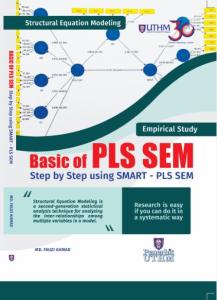BASIC OF PLS SEM STEP BY STEP USING SMART - PLS SEM
Keywords:
Empirical, structural, knowledge, equations, techniqueSynopsis
Finally, I manage to complete writing this book. Thanks to God for giving me, patience and inspiration. Structural Equation Modeling or SEM is a second-generation statistical analysis technique for analyzing the inter-relationships among multiple variables in a model. SEM is an extension of the general linear model (GLM) that enables a researcher to test a set of regression equations simultaneously, SEM software can examine complex relationships and models, such as confirmatory factor analysis and second-order latent variables which improves the weaknesses of ordinary least square (OLS) method. There are two ways to proceed with the structural equation modelling (SEM technique) Covariance-based SEM and PLS-SEM. The selection of the method is based on the normality of data and the type of research. PLS SEM method is used for non-normal data and exploratory research. This book provides researchers with the application of PLS SEM through empirical data focusing on quality management. Empirical data will provide a better understanding of SEM application. I believe that this book will be able to help who are in the theories of applying this technique in their research. Hopefully. this book will provide a useful reference for a better understanding of SEM which can lead to implementing successful research for students and researchers. My sincere, thanks to UTHM for giving me the opportunity to write this book, particularly to share my experience and knowledge in this small contribution.
Downloads
References
Anderson, J. C., M. Rungtusanatham, and R. G. Schroeder. (1994). “A Theory of Quality Management Underlying the Deming Management Method.” Academy of Management Review 19(3):472–509.
Asher, H. .. (1983). Causal Modeling. Newbury Park, CA.: Sage Publication.
Bagozzi, R. P., and Y. Yi. (1988). “On the Evaluation of Structural Equation Models.” Journal of the Academy ofMarketing Science 16(1):74–94.
Barclay, DW, R. Thompson, and C. Higgins. (1995). “The Partial Least Squares (PLS) Approach to Causal Modeling: Personal Computer Adoption and Use an Illustration.” Technol Study 2(2):285–309.
Byrne, B. .. (2010). Structural Equation Modeling with AMOS. 2nd ed. New York: Routledge Francis & Taylor.
Byrne, B. M. (2016). Structural Equation Modelling with AMOS: Basic Concepts, Applications, and Programming. Third. New York: Routledge.
Carmines, E., and R. Zeller. (1979). Reliability and Validity Assessment. London: Sage Publication.
Chi, Anh, Ayman Bahjat, and Yoshiki Matsui. (2011). “Quality Management Practices and Competitive Performance :
Empirical Evidence from Japanese Manufacturing Companies.” Intern. Journal of Production Economics 133(2):518–29. doi: 10.1016/j.ijpe.2011.01.024.




